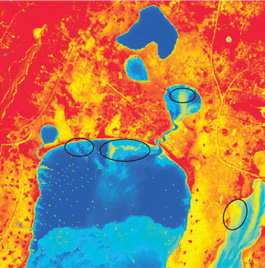home | north bay bohemian index | features | north bay | green zone

Aquified
New technology may force state to accept water's way
By Juliane Poirier
Groundwater is a hidden but vastly needed resource, and conservation advocates are celebrating the work of two German scientists whose research might speed the state into a legislative perspective that aligns with nature and common sense.
Tobias Schmitz and Markus Weiler, researchers at the University of Freiburg's Institute of Hydrology, published in Geophysical Research Letters last week a scientific paper explaining a process for detecting summer and winter inflows of localized groundwater into small streams using "ground-based thermographic systems." Measuring the inflows is possible because the temperatures of the streams differ from those of the groundwater, and infrared pictures map the groundwater's path.
Importantly, this temperature-based measuring method could help force California to alter its legal definition of "groundwater," created when rain is absorbed into the ground and collects in underground aquifers. Ideally, it might also lead to a fairer system for state regulation of water.
Though out of sight, groundwater is nonetheless well-used. The fact is that the water we see is complexly related with that which we don't see—they don't lead separate lives, as they do in legal documents in Sacramento. Common-sense observers have long pointed out that groundwater moves and feeds streams on a regular basis, supplying the critical needs of fish and humans for survival. Unfortunately, the state ignores this information.
In the moisture-limited state of California, our management of groundwater stands shamefully arm in arm with that of Texas, the only other state in the nation where groundwater is not effectively state-regulated. In "Liquid Assets," a report by the California Legislative Analyst's Office, the problem with present law is linked to ignorance of hydrology: "Many western state water laws were initially written in the 1800s and early 1900s, when the scientific knowledge of groundwater was extremely limited. Much like California, most states had statutory definitions of groundwater that had no basis in hydrology.
In normal years, about a third of the state's water needs are met by groundwater. So when droughts place a heavier demand on the underground supplies, it's like placing too many lot straws into the aquifer, and the biggest straws in the aquifer belong to agribusiness. If it's a mammoth underground channel, the state may regulate it, but otherwise, landowners and especially farmers pump merrily away: crops are a $30 billion industry in arid California.
One can only guess that lobbyists for big agribusinesses aren't happy about the new German technology. The rest of us, though, should be breaking out some German beer and pure drinking water, toasting to Schmitz and Weiler and the future triumphs of ground-based thermography.
Send a letter to the editor about this story.
|
|
|
|
|
|